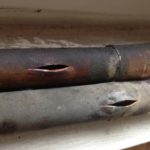What Qualifies As a True Plumbing Emergency?
Knowing some of the key steps to take when a plumbing emergency arises is important. Here are some things to keep in mind.
First, determine whether or not it’s really an emergency. A leaky faucet that has a slow but steady drip probably doesn’t need immediate attention, but a burst pipe under the sink that’s spewing water obviously will. Also, if it’s something that could be easily handled on your own like a clogged toilet, it pays to try out your own efforts first.
If there is a serious leak you’ll need to turn off the water supply to the pipe – and potentially the entire home. Head to the main shutoff valve and turn off the water to ensure that no more leaking occurs.
 Now identify the issue directly. Was it a burst pipe? Try to spot the break. What about a clogged toilet? Can you use the plunger to fix it, or is the plunger not enough? A few minutes of troubleshooting is a good idea – either you will be able to fix the problem on your own, or you will at least be able to give your plumber details about what to expect.
Now identify the issue directly. Was it a burst pipe? Try to spot the break. What about a clogged toilet? Can you use the plunger to fix it, or is the plunger not enough? A few minutes of troubleshooting is a good idea – either you will be able to fix the problem on your own, or you will at least be able to give your plumber details about what to expect.
If the issue demands it, it’s time to contact an emergency plumber. Not all plumbing services are available 24 hours a day, 7 days a week, so you might need to look past the obvious choices and make sure that you call a plumber that will help you no matter what time it is.
These simple steps will help you through a plumbing emergency. They’re easy to take, and well worth remembering when a major issue occurs.
